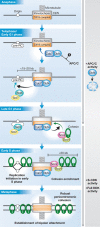Three wise centromere functions: see no error, hear no break, speak no delay
- PMID: 24232185
- PMCID: PMC3849490
- DOI: 10.1038/embor.2013.181
Three wise centromere functions: see no error, hear no break, speak no delay
Abstract
The main function of the centromere is to promote kinetochore assembly for spindle microtubule attachment. Two additional functions of the centromere, however, are becoming increasingly clear: facilitation of robust sister-chromatid cohesion at pericentromeres and advancement of replication of centromeric regions. The combination of these three centromere functions ensures correct chromosome segregation during mitosis. Here, we review the mechanisms of the kinetochore-microtubule interaction, focusing on sister-kinetochore bi-orientation (or chromosome bi-orientation). We also discuss the biological importance of robust pericentromeric cohesion and early centromere replication, as well as the mechanisms orchestrating these two functions at the microtubule attachment site.
Figures









Similar articles
-
Inner centromere localization of the CPC maintains centromere cohesion and allows mitotic checkpoint silencing.Nat Commun. 2017 May 31;8:15542. doi: 10.1038/ncomms15542. Nat Commun. 2017. PMID: 28561035 Free PMC article.
-
Aurora B/AIR-2 regulates sister centromere resolution and CENP-A/HCP-3 organization to prevent merotelic attachments.J Mol Cell Biol. 2025 May 2;16(10):mjae045. doi: 10.1093/jmcb/mjae045. J Mol Cell Biol. 2025. PMID: 39415429 Free PMC article.
-
Kinetochore geometry defined by cohesion within the centromere.Nature. 2009 Apr 16;458(7240):852-8. doi: 10.1038/nature07876. Nature. 2009. PMID: 19370027
-
Correcting aberrant kinetochore microtubule attachments: a hidden regulation of Aurora B on microtubules.Curr Opin Cell Biol. 2019 Jun;58:34-41. doi: 10.1016/j.ceb.2018.12.007. Epub 2019 Jan 23. Curr Opin Cell Biol. 2019. PMID: 30684807 Free PMC article. Review.
-
Regulation of kinetochore-microtubule attachments by Aurora B kinase.Biochem Soc Trans. 2009 Oct;37(Pt 5):976-80. doi: 10.1042/BST0370976. Biochem Soc Trans. 2009. PMID: 19754435 Review.
Cited by
-
GIP Contributions to the Regulation of Centromere at the Interface Between the Nuclear Envelope and the Nucleoplasm.Front Plant Sci. 2016 Feb 8;7:118. doi: 10.3389/fpls.2016.00118. eCollection 2016. Front Plant Sci. 2016. PMID: 26904080 Free PMC article. Review.
-
Rab5a is required for spindle length control and kinetochore-microtubule attachment during meiosis in oocytes.FASEB J. 2014 Sep;28(9):4026-35. doi: 10.1096/fj.14-250886. Epub 2014 May 29. FASEB J. 2014. PMID: 24876181 Free PMC article.
-
Geographic distribution of sex chromosome polymorphism in Anastrepha fraterculus sp. 1 from Argentina.BMC Genet. 2020 Dec 18;21(Suppl 2):149. doi: 10.1186/s12863-020-00944-1. BMC Genet. 2020. PMID: 33339514 Free PMC article.
-
Progress, Challenges, and Surprises in Annotating the Human Genome.Annu Rev Genomics Hum Genet. 2020 Aug 31;21:55-79. doi: 10.1146/annurev-genom-121119-083418. Epub 2020 May 18. Annu Rev Genomics Hum Genet. 2020. PMID: 32421357 Free PMC article. Review.
-
Chromosome segregation in Vibrio cholerae.J Mol Microbiol Biotechnol. 2014;24(5-6):360-70. doi: 10.1159/000368853. Epub 2015 Feb 17. J Mol Microbiol Biotechnol. 2014. PMID: 25732338 Free PMC article. Review.
References
-
- Tanaka TU (2002) Bi-orienting chromosomes on the mitotic spindle. Curr Opin Cell Biol 14: 365–371 - PubMed
-
- Gartenberg M (2009) Heterochromatin and the cohesion of sister chromatids. Chromosome Res 17: 229–238 - PubMed
-
- Hegemann JH, Fleig UN (1993) The centromere of budding yeast. Bioessays 15: 451–460 - PubMed
Publication types
MeSH terms
Substances
Grants and funding
LinkOut - more resources
Full Text Sources
Other Literature Sources

